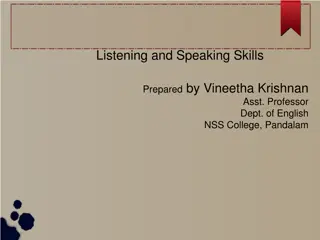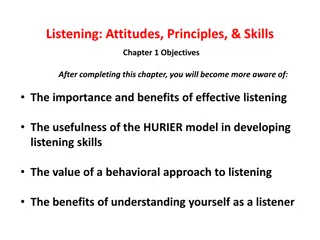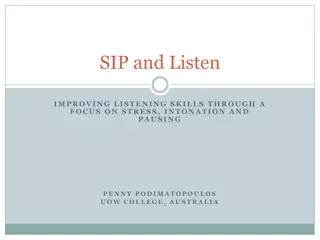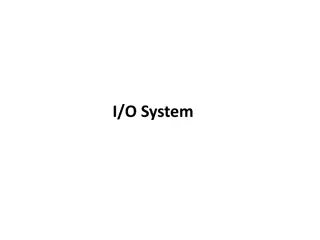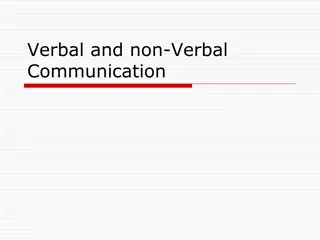Analysis of Standards for Safe Listening Devices
Situation analysis on standards for safe listening devices presented at the ITU-T Workshop highlights the need for a gap analysis in existing standards for safe listening, focusing on personal music players. The report excludes sources like concerts and sporting venues, emphasizing personal audio systems. Identified standards mainly cater to occupational settings and open fields, with few specific to personal media devices. Key standards such as CENELEC EN 50332 are highlighted, addressing sound system equipment associated with personal music players.
Download Presentation

Please find below an Image/Link to download the presentation.
The content on the website is provided AS IS for your information and personal use only. It may not be sold, licensed, or shared on other websites without obtaining consent from the author.If you encounter any issues during the download, it is possible that the publisher has removed the file from their server.
You are allowed to download the files provided on this website for personal or commercial use, subject to the condition that they are used lawfully. All files are the property of their respective owners.
The content on the website is provided AS IS for your information and personal use only. It may not be sold, licensed, or shared on other websites without obtaining consent from the author.
E N D
Presentation Transcript
Situation Analysis on Standards for Safe Listening Sim o Campos ITU-T Study Group 16 "Multimedia" ITU-T Workshop on Standards for Safe Listening Geneva, Switzerland, 6 June 2016
Background Joint WHO-ITU Joint Stakeholders Consultation and Expert Meeting on Safe Listening Devices (Geneva, 1-2 October 2015) Identified need for a gap analysis on standards for safe listening Desk review of existing standards and related info done Nov 2015 Jan 2016 http://itu.int/en/ITU-T/Workshops-and-Seminars/safelistening/Documents/ Standards_for_safe_listening_devices_situation_analysis_report.pdf Focus mainly on personal music players as sources of recreational sound Excludes sources such as concerts, sporting venues and personal sound amplifiers
Definitions Personal audio system: a personal audio system refers to the complete listening system which consists of two parts: 1) the personal music player and 2) the headphones/earphones used with it. Personal music player: a personal music player refers to portable equipment intended for use by an ordinary person, that: Is designed to allow the user to listen to audio or audiovisual content/material; and Uses a listening device, such as headphones or earphones that can be worn in or on or around the ears; and Has a player that can be body worn (of a size suitable to be carried in a clothing pocket) and is intended for the user to walk around while in continuous use (for example, on a street, in a subway, at an airport, etc.). Examples include portable CD players, MP3 audio players, mobile phones with MP3 type features, personal digital assistants (PDAs) or similar equipment. (Excluded from the definition are rehabilitative and medical devices (Hearing aids, FM loops) as well as personal sound amplification devices.) Transducer: in the context of this document, a transducer refers to a earphone/headphone used along with a personal music player for purpose of listening.
Method Report from the October 2015 consultation meeting Literature and website research Access to documentation is limited as they are paying publications
SDOs ANSI, ASA CENELEC, IEC ITU-T, ITU-R
Identified standards Many standards exist for occupational settings Several standards address open field But only a handful of standards are specific to personal media devices/systems
CENELEC EN 50332 Sound system equipment: Headphones and earphones associated with personal music players (PMPs) Maximum sound pressure level measurement methodology EN 50332-1:2013 ( one package equipment , where the headphones and the music player are supplied together as a unit) EN 50332-2:2013 (headphones and the music player supplied separately) EN 50332-3: ongoing work on dosimetry Reduce false warnings (given by part 1 and 2) help protect music integrity by not requiring absolute reduction of music levels of recorded content, but rather managing exposure over time.
IEC IEC/EN 60065:2014: Audio, video and similar electronic apparatus - Safety requirements IEC international standard safety requirements at large Includes specification for sound level limits, to be tested with either EN 50332-1 or EN 50332-2 IEC/EN 62368-1:2014 Audio/video, information and communication equipment Part 1: Safety requirements replaces EN 60065 (A/V equipment), EN 60950-1 (IT & comms eq.) EN 50332 parts 1 and 2 implemented in its clause 10.6 Transposed in US and Canada as CSA/UL 62368-1
ISO ISO 11904 Acoustics Determination of sound immission from sound sources placed close to the ear http://www.iso.org/iso/iso_catalogue/catalogue_tc/catalogue_detail. htm?csnumber=33944 Part 1: Real person Part 2: Manikin
ITU (1) ITU-T P.311 (03/2011) Transmission characteristics for wideband digital handset and headset telephones http://www.itu.int/rec/T-REC-P.311 audio performance requirements and test methods for wideband (8000 Hz) handset and headset telephones ITU-T P.380 (11/2003) Electroacoustic measurements on headsets http://www.itu.int/rec/T-REC-P.380
ITU (2) ITU-T P.381 (02/2014) Technical requirements and test methods for the universal wired headset or headphone interface of digital mobile terminals http://www.itu.int/rec/T-REC-P.381 ITU-R BS.1770-4 (10/2015) - Algorithms to measure audio programme loudness and true-peak audio level http://www.itu.int/rec/R-REC-BS.1770 objective multichannel loudness measurement algorithm for programme delivery and exchange Not compatible with EN 50332 test methods
Standards adoption is voluntary The adoption of standards is by nature voluntary. However, adoption can be mandated: Country or regional level: inclusion in legislation or regulations Private sphere: inclusion in contracts or procurement requirements
European Union and Switzerland Europe Application of EN 50332 (-1, -2) mandated since January 2013 Switzerland: SNEN 60065:2014 (transposition of EN 60065:2014) SNEN 50332:2013 (transposition of EN 50332:2013)
Rest of the world No specific regulations related to recreational use of personal audio systems were found in this study
Implementation by vendors No reference in user messages or documentation on implementation of particular standards Devices Varied warnings about levels Warning seems to be triggered by output level settings, not actual measurements on signal being played Other type of information to users Smartphone vendors seem to be more consistent than MP3 players manufacturers in providing information to users
Current situation (1) At present there are standards developed by the CENELEC which measure sound pressure levels in PMPs. As per these standards, all devices should have a default output limit of 85 dB. The user can choose to override the limit (set by the device), so that the sound level can be increased up to maximum 100 dB. If the user overrides the limit, warnings about the risks must be repeated every 20 hours of listening time. IEC transposed the related CENELEC standards as a global standard Personal music players sold in Europe after February 2013 are expected to comply with these standards. No indication of adherence was found in other parts of the world
Current situation (2) There is a lack of performance/quality certification of some devices in low- and middle-income countries. This makes it easier for counterfeit and low quality devices to inundate the market. The above-mentioned standards do not take into consideration the duration of sound exposure, which is as important as the volume level. Evidence suggests that users often consider the limit set as annoying and frequently override it, ignoring the warning message.
Looking ahead Identify effective hearing protection approach that is acceptable to users Parameters should be identified that assist users to make listening safe whilst maintaining the quality of their listening experience. Dosimetry is an essential part
Points to consider for global standards on safe listening devices (1) Uniform and reliable methods to measure sound output must be applied. Harmonization needed for measurement methods (e.g. ISO 11904- 1/2 or EN 50332-1/2) and reference signals Performance standards need to take into account the sound pressure at the level of the user s ear, not electric levels Players should recognize the transducer used and configure the output volume level and estimate dose, based on the transducer used.
Points to consider for global standards on safe listening devices (2) Profiles could identify from basic devices ("low end") to high-end ones. All devices should provide adequate protection; High-end devices can have more plug-and-play functions and customization options, for example. Profiling could also distinguish level-only and dosimetry enabled devices Apps could be provided for hearing tests by users and use results to set the threshold at which warnings would appear Warning customization to make it more relevant to an individual
Points to consider for global standards (2) Devices display messages suitable to promote safe listening practices. Provide information on the impact of users' decision (to raise or reduce the volume) Warning information should be easy to reach (e.g. a common WHO portal) and to understand Encourage technics for noise reduction, isolation or cancellation Reducing background noise: less need to turn up the music volume
And finally: Standards should be developed and implemented globally collaborative effort of all stakeholders, including all relevant SDOs Implemented by manufacturers of personal music players and of earphones/headphones
Let's make listening both safe and enjoyable Thank you!
ISO TC 43 Harmonize the use of SPL and Lp; Verify applicability of: EN 352-6 Hearing protectors - Safety requirements and testing - Part 6: Ear-muffs with electrical audio input EN 352-8 Hearing protectors - Safety requirements and testing - Part 8: Entertainment audio ear-muffs Comments on dosimetry from Prof Dorte Hammershoi (Aalborg Univ.)








